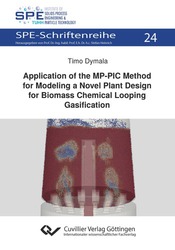| Departments | |
|---|---|
| Book Series (96) |
1378
|
| Nachhaltigkeit |
3
|
| Gesundheitswesen |
1
|
| Humanities |
2363
|
| Natural Sciences |
5406
|
| Engineering |
1791
|
| Engineering | 292 |
| Mechanical and process engineering | 861 |
| Electrical engineering | 686 |
| Mining and metallurgy | 30 |
| Architecture and civil engineering | 75 |
| Common |
98
|
|
Leitlinien Unfallchirurgie
5. Auflage bestellen |
|
Advanced Search
Application of the MP-PIC Method for Modelling a Novel Plant Design for Biomass Chemical Looping Gasification (Volume 24) (English shop)
Timo Dymala (Author)Preview
Extract, PDF (850 KB)
Table of Contents, PDF (33 KB)
To mitigate climate change and to reduce the emissions of greenhouse gases the interest in the utilization of renewable energies has increased drastically in the recent years. Due to the broad availability and its negative carbon emissions biomass is an attractive renewable energy resource. By applying the biomass chemical looping gasification technology the biomass can be used for the generation of electricity or the production of syngas as feedstock for synthetic fuels such as hydrogen and methanol.
To promote the progress of this technology, a novel two-stage design for the gasification reactor is proposed in this work aiming to reduce the undesired tar content in the produced syngas, while maintaining a high syngas yield. To investigate the performance of this design, a reaction model was developed using the so-called multiphase particle-in-cell (MP-PIC) method. Furthermore, optimization recommendations for biomass chemical looping processes in general were derived to adjust the syngas composition and to increase the syngas yield.
| ISBN-13 (Hard Copy) | 9783736978768 |
| ISBN-13 (eBook) | 9783736968769 |
| Final Book Format | B5 |
| Language | English |
| Page Number | 174 |
| Lamination of Cover | matt |
| Edition | 1. |
| Book Series | SPE-Schriftenreihe |
| Volume | 24 |
| Publication Place | Göttingen |
| Publication Date | 2023-09-19 |
| General Categorization | Dissertation |
| Departments |
Allgemeine Verfahrenstechnik
|
| Keywords | CFD simulation, Multiphase particle-in-cell method (MP-PIC), Chemical looping gasification (CLG), Biomass gasification, Syngas, Syngas yield, Syngas composition, Fluidized bed reactor, Oxygen carrier, EMMS drag model, Two-stage fuel reactor, Reaction model, CFD-Simulation, MP-PIC Methode, Chemische Kreislaufvergasung (CLG), Biomassevergasung, Synthesegas, Synthesegasausbeute, Synthesegaszusammensetzung, Wirbelschicht, Sauerstoffträger, EMMS-Widerstandsmodell, Zweistufiger Brennstoffreaktor, Reaktionsmodell |








